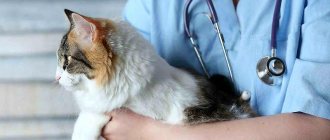Dangerous bacteria
In Australia, an 80-year-old woman died after 9 days in a coma. And, it would seem, there is little extraordinary in such a situation. But a detailed examination revealed that the cause of the coma was the fact that the elderly lady was scratched and licked by her cat. As a result, the woman developed bacterial meningitis, i.e. inflammation of the meninges due to a pathogen of bacterial etiology.
It was the pet that rewarded its owner with the bacterium Pasturella multocida. This pathogen is a rod that is not stable in the external environment and dies when heated or under the influence of ultraviolet radiation. Moreover, such a microbe can survive in soil or manure for 3-4 days.
The infection enters the body through the skin at the site of a bite or scratch left by animals. Inflammation begins in the affected area. But there are also options for hematogenous spread of infection throughout the body.
Protecting yourself from the disease is quite simple in such a situation - you do not need to let animals lick their wounds and other damage to the skin. And if you get a scratch from a claw, you need to treat it with ordinary antiseptics - you can use chlorhexidine or peroxide.
There is no beast more terrible than a cat. Which pets are dangerous for allergy sufferers? Read more
Leukemia (LLC, FeLV)
A viral pathology, highly contagious (infectious) and transmitted by contact. FeLV can be almost immediately destroyed by the animal’s immune system, or, by overcoming protective barriers, it penetrates into red blood cells.
Viremia is the spread of the virus throughout the body through the bloodstream; when FeLV penetrates red blood cells, this is inevitable. All tissues and organs where there are vessels (capillaries) are at risk.
With strong immunity, the virus can “lurk” without identifying itself in any way. As soon as a favorable environment is created for its excessive reproduction, the virus enslaves the body.
The clinical picture of leukemia is extensive; there are no specific signs immediately indicating this disease. Anemia develops, the visible mucous membranes are pale, the cat is apathetic, quickly gets tired, and begins to choke.
As soon as immunity decreases, the likelihood of developing a host of diseases appears, therefore, against the background of leukemia, symptoms of other pathologies appear. Can be:
- skin allergies, inflammation, eczema;
- tumors;
- damage to the reproductive organs;
- respiratory infections;
- damage to the gastrointestinal tract, etc.
Therefore, if there is no positive effect from treatment, the cat must be checked for the presence of retroviruses (immunodeficiency, leukemia).
There is no effective treatment for FeLV. With the help of drugs, they only slightly prolong the life of the animal.
You can get additional advice on the prevention and treatment of dangerous infectious pathologies by visiting the RosVet VC, having previously made an appointment by phone: +7, 24 hours a day.
Scabies manifestations
Experts note that you can also catch a disease such as scabies from cats. The infection is caused by the mite Sarcoptes scabei. This mite is considered an external parasite of the skin of pets. When the pathogen is transferred to human skin, symptoms such as itching and rash in the form of papules begin to appear. Secondary pustules may appear due to scratching and complications against this background.
Again, banal hygiene decides everything - you need to wash your hands more often after contact with your pet, do not kiss him, give him preventive examinations at the veterinarian on time and give him the necessary vaccinations. Naturally, it is necessary to carry out antiparasitic treatment in a timely manner, which will reduce the risks. And, of course, you should change your pet’s litter box with gloves and thoroughly wash your hands with soap after the procedure.
Fungal pathologies
Also unpleasant diseases. Fungal pathologies are dangerous due to their invisibility (at first), difficulty in diagnosing and difficult (including for the human body) treatment. The following cat diseases are dangerous for humans:
- Dermatomycoses, one of the most famous representatives of which is the so-called “ringworm,” also known as trichophytosis. The disease is characterized by the appearance of foci of fungal inflammation, crusts and deep cracks on the skin, hair loss and the growth of scabs on the scalp. The pathology is most dangerous for children and the elderly (due to the weakened immunity of these categories of the population).
- Some types of candidiasis. This is the name for pathologies caused by fungi of the genus Candida. These fungi can cause severe rhinitis, bronchitis, they affect joints, and in advanced cases, even bone tissue. Fortunately, infection with candidiasis from a cat is quite rare. But still, for those same children and the elderly, these diseases are really very dangerous.
Aujeszky's disease
This variant of the disease, experts note, is rare. It also has other names - pseudorabies or meningoencephalitis of an infectious nature. The causative agent is the herpes virus. Cats themselves pick up the pathogen when they eat raw meat if the animal was sick. A person receives such a pathogen through the mucous membranes. It is worth remembering that the pathogen is released in the saliva and snot of a sick cat.
After infection with such a pathology, a person may experience the following symptoms: problems with the nervous system in the form of paralysis, itching in the area of the lips, eyes and on the arms and legs, excessive weaving from the nose, increased fearfulness. The pathology is treated with antibiotics and symptomatic therapy, for example taking antipyretics. Moreover, this therapy applies to cats. In humans, everything goes away on its own after 5-7 days. But it’s still better to see a doctor.
Cat and mouse. Can a pet eat caught birds and rodents? More details
Parasitic diseases
To begin with, we note that all pathologies common to animals and humans are called “zooanthroponoses”.
All of them are, to one degree or another, dangerous for people, and therefore all cases are under separate control not only by the veterinary, but also by the medical service of the specific area. So, the following parasitic pathologies of cats are dangerous for people:
- Toxocariasis. More precisely, only the type of disease caused by parasites of the species Toxocara cati is dangerous for humans. The main danger is migrating worm larvae. They can get anywhere, and therefore the possible consequences of infection include blindness, pathologies of the brain, liver, kidneys, etc.
- Hookworm. A disease caused by the parasite Ancylostoma duodenale. Please note that only people in the Krasnodar Territory and the southern republics of our country are at risk of infection. In other places, this worm (for now, at least) does not survive winter.
- Alveococci. Perhaps this is the most dangerous parasite of all of the above. This is a miniature cestode (flatworm), the consequences of infection of which are not at all miniature. In particular, there are cases of people dying from brain damage.
Cat scratch disease
This pathology is considered quite well known and quite common. The disease in humans begins due to the entry of the bacterium Bartonella henselae. It is normally found in cats' mouths and is part of the animal's natural microflora. The bacterium enters the human body through licks, scratches, bites and other physical contacts made by the cat. First, a raised red spot appears on the skin - as a rule, it is found at the site of a healed scratch. After a couple of days, it becomes a vesicle with cloudy contents, and then turns into an ulcer. After a maximum of one and a half months, an enlargement of the lymph node closest to the site of the lesion develops.
Additional symptoms include fever, pain in the head, muscles and joints, and decreased appetite. Adults who do not have any chronic diseases recover quickly. Those whose immune systems are not working well may develop complications such as eye infections, as well as heart and brain problems.
Cat diseases that are deadly to humans
Not only yard cats, but also domestic couch potatoes can be a source of serious illness. If the disease is not detected in time and adequate therapy is not started, then not only the cat, but also the people around it can suffer.
Rabies
This pathology is of viral origin and affects the nervous system of a mammal. Rabies is most often recorded in whiskers walking on the street, but it can also appear in a completely indoor cat.
Infection occurs from contact with the saliva of infected individuals: sick rodents, foxes, infected relatives. Rabies in animals cannot be cured, so the infected patient always dies.
The main symptoms of a fatal disease:
- aggressive or overly affectionate behavior;
- fear of light and water;
- profuse drooling;
- convulsions;
- paralysis;
- gait disturbances.
If the owner or members of his family are bitten by a rabid pet, they must immediately go to the hospital. The doctor prescribes the administration of anti-rabies serum for 3 days. If treatment is not started on time, the person will die. Only regular vaccination will help prevent the mustache from becoming infected.
Chlamydia
Another dangerous disease that is transmitted by airborne droplets is chlamydia (another type, not the one that is human and sexually transmitted). It occurs when a mustachioed friend eats a sick mouse or rat. Death in the absence of proper treatment occurs within a few days.
Signs of chlamydia:
- purulent discharge from the eyes;
- lethargy;
- lack of appetite;
- cough and hoarseness;
- runny nose, sometimes with pus.
In humans, the symptoms of feline chlamydia manifest themselves in an acute form of pneumonia. After making a diagnosis, the doctor prescribes a course of antimicrobial drugs. In advanced cases, urgent hospitalization is necessary. Lack of proper therapy leads to tragic consequences, including death.
Tuberculosis
The appearance of tuberculosis is caused by an infection called Koch's bacillus. It can be found in raw milk or meat. Another source is contact with an infected person. Almost every case of tuberculosis in a four-legged patient ends in death.
Symptoms include:
- sneezing and coughing;
- lethargy and apathy;
- disturbances in the gastrointestinal tract;
- the appearance of nodules on the head and neck.
A person's respiratory system is damaged and the immune system malfunctions. The owner and family members are exposed to tuberculosis if the rules of personal hygiene are neglected. Early diagnosis and treatment provide a good chance of recovery.
Leptospirosis
This is a disease caused by pathogenic microorganisms called Leptospira. They affect most of the pet’s internal organs: liver, kidneys, eyes, reproductive organs, central nervous system. Infection occurs from a sick individual as a result of direct or indirect contact.
The main manifestations of leptospirosis are:
- fever;
- trembling and muscle pain;
- apathy and lack of appetite;
- refusal to drink and further dehydration of the body;
- bloody diarrhea;
- swelling of the mucous membranes.
In humans, the manifestation of signs of infection is similar to the development of a respiratory disease. Sometimes yellowing of the eyeball is observed. The success of treating infected people depends on the speed of visiting a doctor, making a diagnosis and prescribing drug therapy. Deaths occur, but are rare.
Salmonellosis
Most often, kittens and young animals up to one and a half years old suffer from salmonellosis. The infection enters the body as a result of eating foods containing salmonella. It can be raw eggs, fish, milk. Without immediate medical assistance, the animal dies, mainly from dehydration.
Signs of salmonellosis:
- copious amounts of saliva;
- heat;
- pus in the eyes and nose;
- diarrhea;
- lack of appetite and weakness;
- frequent vomiting;
- breathing problems.
Salmonellosis is transmitted through close contact with an infected individual and leads to severe intoxication in humans. Without obtaining the necessary medications, death is possible. The best way to avoid salmonella is to eat only processed foods.
Rabies
Of course, one of the most dangerous diseases that pets can transmit is rabies. Moreover, for a person, if the necessary measures are not taken in time, it is fatal. Rabies is characterized by a whole complex of symptoms, one of the most characteristic is hydrophobia, when even when trying to drink ordinary water, a convulsive syndrome develops. In addition, the nervous system suffers greatly, and many systems in the body begin to fail.
The simplest option for such a dangerous and deadly disease is prevention in the form of a vaccine - it is enough to vaccinate the animal against rabies on time to reduce the risks to virtually zero. If a situation occurs where there is contact with a sick animal, a person should consult a doctor as soon as possible and undergo a course of preventive vaccinations that will allow him to save his life.
40 injections in the stomach? Myths and truth about rabies Read more
How to protect your pet from diseases
It is not difficult to prevent the transmission and development of ailments dangerous to people. Proper care, a balanced diet and regular visits to the veterinary clinic will help protect your furry pet and the people living with it.
Annual vaccination
Timely vaccination can relieve many problems and strengthen the immunity of your four-legged friend. Mandatory vaccinations include annual rabies vaccinations, as well as vaccinations against the most common viral pathologies. The introduction of some drugs is not an absolute guarantee against infection, but in any case it stimulates the strengthening of the immune system.
Flea treatment
Veterinary pharmacies and pet stores offer a large selection of remedies for external parasites. They are produced in the form of shampoos, lotions, sprays, drops on the withers and collars. Treatment of mustaches should be carried out at least twice a year. Cats that walk outside can be treated as needed - up to once a month.
Regular deworming
Treatment for worms must be carried out in a timely manner. On average, deworming is performed at least once a quarter. This will help prevent intestinal parasites from entering the cat and preventing infection of the people around him. To carry out the procedure, it is enough to use special tablets or suspensions and give them strictly according to the instructions.
Animal blood donation
Regular visits to the veterinarian are important. It is better to do this at least once a year, even if your four-legged friend looks completely healthy. After examining the patient and talking with the owner, the veterinarian takes the cat's blood for analysis. The study will help identify possible hidden problems and quickly begin to treat them.
Safety regulations
It is quite possible to prevent illness from your pet. Simple rules will help prevent infection. The main thing is to visit a doctor with your animal on time, get all the necessary vaccinations, and monitor the animal’s condition. And, of course, it is worth excluding potentially dangerous contacts as much as possible, such as licking wounds - after all, the open surface should not be actively exposed to potentially pathogenic microflora.
You should also wash your hands more often after playing with your pet and before eating or drinking. And, of course, you should not allow the animal to eat from the same plate as the owner. Special attention should be paid to the selection of products and food for your pet - meat should be purchased only from trusted manufacturers, and also monitor the expiration date on food packages. And then the animal owner will not have any health problems.
Protozoal infections
This is the name for diseases caused by parasitic protozoa. The following are dangerous to humans:
- Toxoplasmosis. The variant caused by Toxoplasma gondii is dangerous to humans. In adults, infection causes flu-like symptoms. Characterized by muscle aches, joint pain, and general weakness. As a rule, normal immunity copes with the parasite, but... Toxoplasmosis is extremely dangerous for pregnant women! In these cases, infection can lead to abortions, severe gynecological pathologies, but what is much worse - with toxoplasmosis, a woman may well give birth to a child with deformities, mental pathologies, missing internal organs, etc.
- Chlamydia. The risk of contracting chlamydia from a cat is quite low, but it does exist (in children, the elderly and pregnant women). Symptoms of the disease include: conjunctivitis (the most typical symptom), bronchitis, rhinitis, and in some cases chronic digestive disorders develop. As in the previous case, the disease is extremely dangerous for pregnant women. In addition, in recent years, doctors believe that about 25% of all deaths from sudden heart attacks are a consequence of chronic chlamydia.
Oncology of cats and cats
If cancer is not detected in the early stages, the outcome can be fatal.
Mammary cancer
On initial palpation it may resemble a pea, but over time the tissue grows and a tumor forms, most often malignant. It is more often diagnosed in females who have not given birth. Short-haired breeds are often affected.
Symptoms
- Swelling of the nipples.
- Dense knots.
- Discharge.
- Ulcers on the skin.
- Temperature increase.
- Weight loss.
- Refusal of food.
- Lethargy.
At the first manifestations, you should show it to a qualified specialist.
Lymphoma
The most common disease that affects lymphocytes and lymphoid tissue.
Causes:
- ecology;
- heredity;
- leukemia
Symptoms
- Weight loss.
- Vomiting or diarrhea.
- Enlarged lymph nodes.
- Dyspnea.
- Suffocation.
The main thing is to have time to show your pet at the initial stage of the disease in order to save his life.
Squamous cell carcinoma
It affects the epithelial layer of the skin and is most often formed in the mouth. It is removed surgically.
Symptoms
- Wounds that do not heal for a long time.
- Ulcers.
- Redness of some areas of the skin.
Cancers are most often found in the ears, nose, or mouth.
Sarcoma
The most aggressive type of cancer. It is necessary to monitor the cat, examine its skin, and also look in its mouth so as not to miss tumors. There are many types of sarcoma lesions, which most often cannot be cured, but only symptomatic treatment can make life easier for the pet.
How to tell if your cat is not okay
The prognosis for the treatment of cat diseases depends on the symptoms and the time of their detection. Changes in the pet’s usual state are:
1. Behavioral.
If an active and always hungry cat spends the entire day on the couch, avoids communication and refuses his favorite food, sound the alarm. Reverse changes are no less dangerous. Excessive activity and increased appetite, which are not characteristic of an animal, are a sign of a malfunction within the body.
2. Physiological.
This group includes more obvious violations that are understandable not only to the owner, but also to an outsider:
- intestinal disorder (diarrhea, constipation);
- difficulty urinating;
- nausea and vomiting;
- the appearance of redness and peeling on the skin;
- hair loss;
- loss of coordination;
- increase or decrease in normal temperature;
- increased or slow heart rate;
- excessive discharge from the eyes, nose or ears.
Of particular danger is the appearance of blood in stool or vomit. This symptom always accompanies internal injuries and requires urgent assistance from a veterinarian.
Kidney failure in cats
Kidney failure is one of the leading causes of death in aging cats. The risk of developing such a renal pathology depends on the age, genetics of the animal, as well as environmental factors, such as, for example, accidental poisoning with toxic substances. Kidney failure in this species of animal can have two forms: acute or chronic. Acute renal failure in cats is associated with a sudden stop in kidney function, for example, from the same poisoning, while the chronic form of the disease is based on a gradual progressive deterioration of renal functionality, for example, from concomitant diseases.
Symptoms of kidney failure in cats:
- Excessive urination.
- Increased thirst.
- Nausea.
- Vomit.
- Dehydration.
- Constipation.
- Loss of appetite and weight.
- Unpleasant odor of ammonia from the mouth.
- General weakness and lethargy.
There is no specific treatment against acute or chronic renal disease in cats. All therapeutic regimens are aimed exclusively at suppressing symptoms and maintaining the quality of life of pets. According to veterinary statistics, animals receiving conservative symptomatic treatment can survive for quite long periods of time using only 5 to 8 percent of their kidney tissue.
Infectious diseases
Infections dangerous to humans include the following pathologies:
- Rabies. An absolutely fatal (once symptoms appear) infection. For this reason, cats must be vaccinated annually!
- Tuberculosis. The cat variety, by the way, is one of the most dangerous. Note that tuberculosis refers not only to zoonoses, but also to anthropozoonoses. Simply put, a person can become infected with tuberculosis from a cat, and a cat from a person. Therefore, you should not take kittens from families where at least one of the family members has ever had tuberculosis!
- Salmonellosis. Since cats can eagerly hunt and eat various “living creatures” during walks, they often become infected. Salmonellosis can be transmitted to humans, the main symptom of infection is severe intestinal disorders (accompanied by the release of black feces, melena). Fever and severe, sudden spasmodic pain in the stomach are also characteristic.
Diseases common in kittens
For kittens, pathologies accompanied by vomiting and diarrhea are especially dangerous. The likelihood of death with rapid dehydration is maximum. Babies can catch the infection both from outside and from their mother. Therefore, it is especially important to protect very young kittens that have not yet been vaccinated.
Most often, kittens are diagnosed with the following diseases:
- Otodectosis
. If intense itching, redness and brown-black discharge from the ears appear, not only the infected person, but also other pets are treated.
- Flea infestations
. Severe infection can lead to anemia. Fleas can also be carriers of mycoplasmas and infect the baby with mycoplasmosis.
- Panleukopenia
. When infected, a fulminant form is often observed. The baby fades away within a day.
- Upper respiratory tract infections (calcivirosis, rhinotracheitis)
. Accompanied by a runny nose, sneezing and lacrimation. It spreads quickly from one animal to another and requires mandatory treatment.
- Helminthiasis
. Intestinal parasites can be transmitted through breast milk or through contact with outdoor shoes. Worm the animals before mating and keep the kittens in an enclosure until the first vaccination and anthelmintic treatment.
For the health of your fur baby, vaccinate it immediately after separation from its mother. This will help protect it from most dangerous infections.










